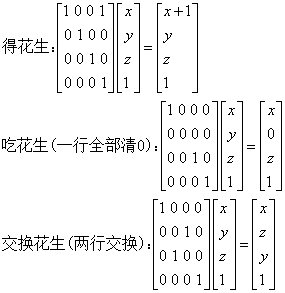| Time Limit: 2000MS | Memory Limit: 65536K | |
| Total Submissions: 9613 | Accepted: 2296 |
Description
Facer's pet cat just gave birth to a brood of little cats. Having considered the health of those lovely cats, Facer decides to make the cats to do some exercises. Facer has well designed a set of moves for his cats. He is now asking you to supervise the cats to do his exercises. Facer's great exercise for cats contains three different moves:
g i : Let the ith cat take a peanut.
e i : Let the ith cat eat all peanuts it have.
s i j : Let the ith cat and jth cat exchange their peanuts.
All the cats perform a sequence of these moves and must repeat it m times! Poor cats! Only Facer can come up with such embarrassing idea.
You have to determine the final number of peanuts each cat have, and directly give them the exact quantity in order to save them.
Input
The input file consists of multiple test cases, ending with three zeroes "0 0 0". For each test case, three integers n, m and k are given firstly, where n is the number of cats and k is the length of the move sequence. The following k lines describe the sequence.
(m≤1,000,000,000, n≤100, k≤100)
Output
For each test case, output n numbers in a single line, representing the numbers of peanuts the cats have.
Sample Input
3 1 6 g 1 g 2 g 2 s 1 2 g 3 e 2 0 0 0
Sample Output
2 0 1
Source

/*
稀疏矩阵乘法优化
*/
for (int i = 0; i < n; i++)
for (int j = 0; j < m; j++) {
if (!a[i][j]) continue; //稀疏矩阵乘法优化
for (int k = 0; k < b.m; k++)
tmp.a[i][k] += a[i][j] * b.a[j][k];
}
2. 虽然M,N,K都是 int 范围的,但是操作之后,每只猫的花生数量会超 int。
/*
ID: wuqi9395@126.com
PROG:
LANG: C++
*/
#include<map>
#include<set>
#include<queue>
#include<stack>
#include<cmath>
#include<cstdio>
#include<vector>
#include<string>
#include<fstream>
#include<cstring>
#include<ctype.h>
#include<iostream>
#include<algorithm>
#define INF (1<<30)
#define PI acos(-1.0)
#define mem(a, b) memset(a, b, sizeof(a))
#define For(i, n) for (int i = 0; i < n; i++)
typedef long long ll;
using namespace std;
const int maxn = 110;
const int maxm = 110;
const int mod = 10000;
struct Matrix {
int n, m;
ll a[maxn][maxm];
void clear() {
n = m = 0;
memset(a, 0, sizeof(a));
}
Matrix operator * (const Matrix &b) const {
Matrix tmp;
tmp.clear();
tmp.n = n; tmp.m = b.m;
for (int i = 0; i < n; i++)
for (int j = 0; j < m; j++) {
if (!a[i][j]) continue; //稀疏矩阵乘法优化
for (int k = 0; k < b.m; k++)
tmp.a[i][k] += a[i][j] * b.a[j][k];
}
return tmp;
}
};
int n, k, m;
void init(int n, Matrix &I) {
for (int i = 0; i <= n; i++) {
for (int j = 0; j <= n; j++) {
I.a[i][j] = 0LL;
}
I.a[i][i] = 1LL;
}
I.n = I.m = n + 1;
}
Matrix Matrix_pow(Matrix A, int k) {
Matrix res;
init(n, res);
while(k) {
if (k & 1) res = res * A;
k >>= 1;
A = A * A;
}
return res;
}
int main () {
Matrix A, I, res;
while(scanf("%d%d%d", &n, &m, &k)) {
if (m == 0 && n == 0 && k == 0) {
break;
}
A.clear();
A.n = n + 1; A.m = 1;
A.a[n][0] = 1LL;
char ch;
int u, v;
init(n, res);
while(k--) {
init(n, I);
getchar();
scanf("%c", &ch);
if (ch == 'g') {
scanf("%d", &u);
I.a[u - 1][n] = 1LL;
}
if (ch == 's') {
scanf("%d%d", &u, &v);
I.a[u - 1][u - 1] = 0LL; I.a[u - 1][v - 1] = 1LL;
I.a[v - 1][v - 1] = 0LL; I.a[v - 1][u - 1] = 1LL;
}
if (ch == 'e') {
scanf("%d", &u);
I.a[u - 1][u - 1] = 0LL;
}
res = I * res; //每次操作时,I应该乘在前面,因为矩阵乘法没有交换律
}
Matrix tmp = Matrix_pow(res, m);
tmp = tmp * A;
for (int i = 0; i < n; i++) {
printf("%lld ", tmp.a[i][0]);
}
cout<<endl;
}
return 0;
}
上述图片来自: http://blog.csdn.net/magicnumber/article/details/6217602
























 781
781

 被折叠的 条评论
为什么被折叠?
被折叠的 条评论
为什么被折叠?








